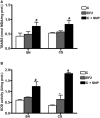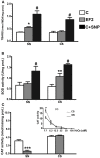Differential vulnerability of substantia nigra and corpus striatum to oxidative insult induced by reduced dietary levels of essential fatty acids
- PMID: 22969716
- PMCID: PMC3431008
- DOI: 10.3389/fnhum.2012.00249
Differential vulnerability of substantia nigra and corpus striatum to oxidative insult induced by reduced dietary levels of essential fatty acids
Abstract
Oxidative stress (OS) has been implicated in the etiology of certain neurodegenerative disorders. Some of these disorders have been associated with unbalanced levels of essential fatty acids (EFA). The response of certain brain regions to OS, however, is not uniform and a selective vulnerability or resilience can occur. In our previous study on rat brains, we observed that a two-generation EFA dietary restriction reduced the number and size of dopaminergic neurons in the substantia nigra (SN) rostro-dorso-medial. To understand whether OS contributes to this effect, we assessed the status of lipid peroxidation (LP) and anti-oxidant markers in both SN and corpus striatum (CS) of rats submitted to this dietary treatment for one (F1) or two (F2) generations. Wistar rats were raised from conception on control or experimental diets containing adequate or reduced levels of linoleic and α-linolenic fatty acids, respectively. LP was measured using the thiobarbituric acid reaction method (TBARS) and the total superoxide dismutase (t-SOD) and catalase (CAT) enzymatic activities were assessed. The experimental diet significantly reduced the docosahexaenoic acid (DHA) levels of SN phospholipids in the F1 (~28%) and F2 (~50%) groups. In F1 adult animals of the experimental group there was no LP in both SN and CS. Consistently, there was a significant increase in the t-SOD activity (p < 0.01) in both regions. In EF2 young animals, degeneration in dopaminergic and non-dopaminergic neurons and a significant increase in LP (p < 0.01) and decrease in the CAT activity (p < 0.001) were detected in the SN, while no inter-group difference was found for these parameters in the CS. Conversely, a significant increase in t-SOD activity (p < 0.05) was detected in the CS of the experimental group compared to the control. The results show that unbalanced EFA dietary levels reduce the redox balance in the SN and reveal mechanisms of resilience in the CS under this stressful condition.
Keywords: DHA; catalase; corpus striatum; lipid peroxidation; neurodegeneration; oxidative stress; substantia nigra; superoxide dismutase.
Figures





Similar articles
-
Omega-3 deficiency and neurodegeneration in the substantia nigra: involvement of increased nitric oxide production and reduced BDNF expression.Biochim Biophys Acta. 2014 Jun;1840(6):1902-12. doi: 10.1016/j.bbagen.2013.12.023. Epub 2013 Dec 20. Biochim Biophys Acta. 2014. PMID: 24361617
-
Dopaminergic cell populations of the rat substantia nigra are differentially affected by essential fatty acid dietary restriction over two generations.J Chem Neuroanat. 2012 Jul;44(2):66-75. doi: 10.1016/j.jchemneu.2012.05.003. Epub 2012 Jun 9. J Chem Neuroanat. 2012. PMID: 22687395
-
Potential role of dietary omega-3 essential fatty acids on some oxidant/antioxidant parameters in rats' corpus striatum.Prostaglandins Leukot Essent Fatty Acids. 2003 Oct;69(4):253-9. doi: 10.1016/s0952-3278(03)00107-8. Prostaglandins Leukot Essent Fatty Acids. 2003. PMID: 12907135
-
Increased oxidative damage and decreased antioxidant function in aging human substantia nigra compared to striatum: implications for Parkinson's disease.Neurochem Res. 2012 Feb;37(2):358-69. doi: 10.1007/s11064-011-0619-7. Epub 2011 Oct 5. Neurochem Res. 2012. PMID: 21971758
-
Lipid peroxidation-mediated oxidative stress and dopamine neuronal apoptosis in the substantia nigra during development.Neurochem Int. 2001 Aug;39(2):127-33. doi: 10.1016/s0197-0186(01)00013-4. Neurochem Int. 2001. PMID: 11408091
Cited by
-
Basal ganglia vulnerability to oxidative stress.Front Neurosci. 2014 Apr 21;8:80. doi: 10.3389/fnins.2014.00080. eCollection 2014. Front Neurosci. 2014. PMID: 24795555 Free PMC article. No abstract available.
-
Nutritional habits, risk, and progression of Parkinson disease.J Neurol. 2018 Jan;265(1):12-23. doi: 10.1007/s00415-017-8639-0. Epub 2017 Oct 10. J Neurol. 2018. PMID: 29018983 Review.
-
Brain Networks Reorganization During Maturation and Healthy Aging-Emphases for Resilience.Front Psychiatry. 2018 Nov 21;9:601. doi: 10.3389/fpsyt.2018.00601. eCollection 2018. Front Psychiatry. 2018. PMID: 30519196 Free PMC article. Review.
-
Environmental Enrichment Attenuates Oxidative Stress and Alters Detoxifying Enzymes in an A53T α-Synuclein Transgenic Mouse Model of Parkinson's Disease.Antioxidants (Basel). 2020 Sep 28;9(10):928. doi: 10.3390/antiox9100928. Antioxidants (Basel). 2020. PMID: 32998299 Free PMC article.
-
Omega-3 Fatty Acids: Possible Neuroprotective Mechanisms in the Model of Global Ischemia in Rats.J Nutr Metab. 2016;2016:6462120. doi: 10.1155/2016/6462120. Epub 2016 May 24. J Nutr Metab. 2016. PMID: 27313881 Free PMC article.
References
-
- Aebi H. (1984). Catalase in vitro. Methods Enzymol. 105, 121–126 - PubMed
-
- Ahmad S. O., Park J. H., Radel J. D., Levant B. (2008). Reduced numbers of dopamine neurons in the substantia nigra pars compacta and ventral tegmental area of rats fed an n-3 polyunsaturated fatty acid-deficient diet: a stereological study. Neurosci. Lett. 438, 303–307 10.1016/j.neulet.2008.04.073 - DOI - PMC - PubMed
-
- Berry J. F., Cevallos W. H., Wade R. R. (1965). Lipid class and fatty acid composition of intact peripheral nerve and during Wallerian degeneration. J. Am. Oil Chem. Soc. 42, 492–500 - PubMed
LinkOut - more resources
Full Text Sources
Miscellaneous

